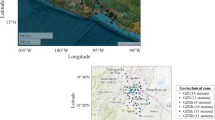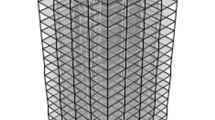Abstract
This paper presents a method for modeling the ground vibrations from a railway tunnel in layered unsaturated soil, considering the uncertainty and spatial variability of soil parameters. A deterministic ground vibration prediction model, which is an improved Euler beam model, is developed to evaluate the vibrations for a tunnel in layered unsaturated soil. Furthermore, the spatial variability of soil parameters is simulated by random fields using the Monte Carlo theory and the middle point method of Cholesky decomposition. By coupling the random fields of soil parameters to the deterministic vibration prediction model, the effect of uncertainty and spatial variability of soil on the ground vibrations is demonstrated through a case study. It is found that the variability of soil parameters has little influence on the spatial distribution regularities of ground vibrations, but it has a significant effect on the dynamic response amplitude and the critical velocity of the system.












Similar content being viewed by others
References
Balendra T, Koh CG, Ho YC. Dynamic response of buildings due to trains in underground tunnels. Earthq Eng Struct Dynam. 1991;20(3):275–91. https://doi.org/10.1002/eqe.4290200306.
Sheng XZ. A review on modelling ground vibrations generated by underground trains. Int J Rail Transp. 2019;7(4):241–61. https://doi.org/10.1080/23248378.2019.1591312.
Di H, Zhou S, Yao X, Tian Z (2021) In situ grouting tests for differential settlement treatment of a cut-and-cover metro tunnel in soft soils. Bullet Eng Geol Environ 80(8):6415–6427. https://doi.org/10.1007/s10064-021-02276-5
Phoon KK, Kulhawy FH. Characterization of geotechnical variability. Can Geotech J. 1999;36(4):612–24. https://doi.org/10.1139/cgj-36-4-612.
Thiede R, Natke HG. The influence of thickness vibration of subway walls on the vibration emission generated by subway traffic. In: Soil Dynamics and Earthquake Engineering V First Int Conf Soil Dyn Earthquake. 1991; pp 672–682.
He ZX, Zhai WM, Luo Z. Ground vibration caused by moving metro trains. J Southwest Jiaotong Univ. 2008;43(2):218-221+247. https://doi.org/10.3969/j.issn.0258-2724.2008.02.013.
Xie WP, Sun HG. Fem analysis on wave propagation in soils induced by high speed train loads. Chin J Rock Mech Eng. 2003;22(7):1180–4. https://doi.org/10.3321/j.issn:1000-6915.2003.07.025.
Bian XC, Jin WF, Jiang HG. Ground-borne vibrations due to dynamic loadings from moving trains in subway tunnels. J Zhejiang Univ-Sci A (Appl Phys Eng). 2012;13(11):870–6. https://doi.org/10.1631/jzus.A12ISGT5.
Degrande G, Clouteau D, Othman R, Arnst M, Chebli H, Klein R, Chatterjee P, Janssens B. A numerical model for ground-borne vibrations from underground railway traffic based on a periodic finite element-boundary element formulation. J Sound Vib. 2006;293(35):645–66. https://doi.org/10.1016/j.jsv.2005.12.023.
Liu WF, Liu WN, Gupta S, Degrande G. A coupled periodic finite element-boundary element model for prediction of vibrations induced by metro traffic. J Vib Eng. 2009;22(5):480–5. https://doi.org/10.3969/j.issn.1004-4523.2009.05.007.
Sheng X, Jones CJC, Thompson DJ. Modelling ground vibration from railways using wavenumber finite and boundary-element methods. Math Phys Eng Sci. 2005;461:2043–70. https://doi.org/10.1098/rspa.2005.1450.
He C, Zhou SH, Di HG, Shan Y. A 2.5-D coupled FE–BE model for the dynamic interaction between saturated soil and longitudinally invariant structures. Comput Geotech. 2017;82:211–22. https://doi.org/10.1016/j.compgeo.2016.10.005.
Hung HH, Chen GH, Yang YB. Effect of railway roughness on soil vibrations due to moving trains by 2.5 D finite/infinite element approach. Eng Struct. 2013;57:254–66. https://doi.org/10.1016/j.engstruct.2013.09.031.
Liu WN, Ma M, Liu WF, Sun XJ, Sun FQ. Overview on current research of environmental vibration influence induced by urban mass transit in China. Scientia Sinica: Technologica. 2016;46:547–59. https://doi.org/10.1360/N092015-00334.
Kouroussis G, Vogiatzis KE, Connolly DP. A combined numerical/experimental prediction method for urban railway vibration. Soil Dyn Earthq Eng. 2017;97:377–86. https://doi.org/10.1016/j.soildyn.2017.03.030.
Metrikine AV, Vrouwenvelder ACWM. Surface ground vibration due to a moving train in a tunnel: two-dimensional model. J Sound Vib. 2000;234(1):43–66. https://doi.org/10.1006/jsvi.1999.2853.
Hu AF, Li YJ, Deng YB, Xie KH. Vibration of layered saturated ground with a tunnel subjected to an underground moving load. Comput Geotech. 2020;119:103342. https://doi.org/10.1016/j.compgeo.2019.103342.
Forrest JA, Hunt HEM. A three-dimensional model for calculation of train-induced ground vibration. J Sound Vib. 2006;294(4/5):678–705. https://doi.org/10.1016/j.jsv.2005.12.032.
Di HG, Zhou SH, He C, Zhang XH, Luo Z. Three-dimensional multilayer cylindrical tunnel model for calculating train-induced dynamic stress in saturated soils. Comput Geotech. 2016;80:333–45. https://doi.org/10.1016/j.compgeo.2016.08.005.
Yuan ZH, Boström A, Cai YQ. Benchmark solution for vibrations from a moving point source in a tunnel embedded in a half-space. J Sound Vib. 2017;387:177–93. https://doi.org/10.1016/j.jsv.2016.10.016.
He C, Zhou SH, Guo PJ, Gong QM. Three-dimensional analytical model for the dynamic interaction of twin tunnels in a homogeneous half-space. Acta Mech. 2019;230:1159–79. https://doi.org/10.1007/s00707-018-2330-0.
Shu Y, Shan Y, Zhou SH, Yang XW. Influence on vehicle-track-subgrade system dynamic response induced by track stiffness variation. J Tongji Univ (Natl Sci). 2017;45(5):721–31. https://doi.org/10.1908/j.issn.0253-374x.2017.05.014.
Chen FY, Zhang J, Zhang XL, Feng SJ. Prediction of vibration induced by high-speed train: consideration of soil spatial variability. Geo-Risk. 2017. https://doi.org/10.1061/9780784480717.041.
Di HG, Zhou SH, Guo HJ, He C, Zhang XH. Three-dimensional analytical model for vibrations from a tunnel embedded in an unsaturated half-space. Acta Mech. 2021;02:1–20. https://doi.org/10.1007/s00707-020-02892-4.
Liu XW. Fundamentals of elastic wave field-theory. Qingdao: Ocean University of China Press; 2008.
Huang HW, Gong WP, Khoshnevisan S, Juang CH, Zhang DM, Wang L. Simplified procedure for finite element analysis of the longitudinal performance of shield tunnels considering spatial soil variability in longitudinal direction. Comput Geotech. 2015;64:132–45. https://doi.org/10.1016/j.compgeo.2014.11.010.
Sert S, Luo Z, Xiao JH, Gong WP, Juan CH. Probabilistic analysis of responses of cantilever wall-supported excavations in sands considering vertical spatial variability. Comput Geotech. 2016;75:182–91. https://doi.org/10.1016/j.compgeo.2016.02.004.
Luo Z, Hu B, Wang YW, Di HG. Effect of spatial variability of soft clays on geotechnical design of braced excavations: a case study of Formosa excavation. Comput Geotech. 2018;103:242–53. https://doi.org/10.1016/j.compgeo.2018.07.020.
Luo Z, Hu B. Probabilistic design model for energy piles considering soil spatial variability. Comput Geotech. 2019;108:308–18. https://doi.org/10.1016/j.compgeo.2019.01.003.
Kasama K, Whittle AJ. Bearing capacity of spatially random cohesive soil using numerical limit analyses. J Geotech Geoenviron Eng. 2011;137(11):989–96. https://doi.org/10.1061/(ASCE)GT.19435606.0000531.
Vanmarcke EH. Probabilistic modeling of soil profiles. J Geotech Eng Div ASCE. 1977;103(GT11):1227–46. https://doi.org/10.1016/0148-9062(78)90012-8.
Fenton GA, Griffiths DV. Risk assessment in geotechnical engineering. New York: Wiley; 2008.
Acknowledgements
This study was supported by the National Natural Science Foundation of China through Grant No. 51808405 and Natural Science Foundation of Shanghai 20ZR1459900.
Author information
Authors and Affiliations
Corresponding author
Ethics declarations
Conflict of interest
The author(s) declare no potential conflicts of interest in terms of the research, authorship, and/or publication of this article.
Additional information
Publisher's Note
Springer Nature remains neutral with regard to jurisdictional claims in published maps and institutional affiliations.
Appendices
Appendix A
Appendix B
Rights and permissions
About this article
Cite this article
Di, H., Yu, J., Guo, H. et al. Modeling of ground vibrations from a tunnel in layered unsaturated soil with spatial variability. Archiv.Civ.Mech.Eng 22, 33 (2022). https://doi.org/10.1007/s43452-021-00358-5
Received:
Revised:
Accepted:
Published:
DOI: https://doi.org/10.1007/s43452-021-00358-5




